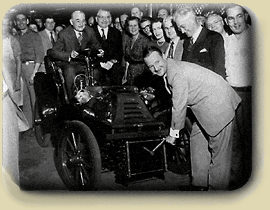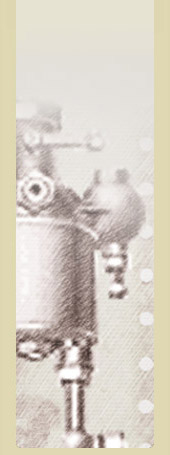1946-1965
The Second Generation Takes The Wheel
Following the war, Holley concentrated on keeping up with the requirements of car manufacturers who,
in turn, were trying to meet the demands of a car-hungry public. At the same time, Holley's research and
engineering departments were busy at work, developing new and advanced carburetors and ignition
equipment for the cars of the future.
 One result of this research was a new line of side air inlet carburetors, developed for heavy-duty
truck and bus applications.
One result of this research was a new line of side air inlet carburetors, developed for heavy-duty
truck and bus applications.
In 1946, the automotive industry celebrated its Golden Jubilee, and George M. Holley
was named to the Automotive Hall of Fame. That same year, Holley opened its
Clare, Michigan plant, and George Holley, Jr. became vice president and general
manager of Holley Carburetor Company. Under his direction, Holley developed
and manufactured fuel control devices for planes equipped with gas turbine and jet engines.
In 1948, the Holley plant in Paris, Tennessee, opened. The following year, Holley
introduced the first pressure distributor, an important contribution to ignition
efficiency, and the advance-design four-barrel carburetor to keep pace with
the growing power requirements of American-made automobiles. During this
time, Holley also entered the automotive after-market by supplying carburetor
repair kits and genuine Holley parts to garages and service stations.
In 1951, Holley closed its main plant in Detroit and moved its operations to
Warren, Michigan. The following year, the plant in Bowling Green, Kentucky, opened.
In 1953, co-founder Earl Holley retired, and the second generation of Holleys
began running the company. George Holley, Jr. became president of the company,
Danforth Holley became the Director of Cost Savings, and Jack Holley became
the Vice President of Sales. Under their leadership, Holley expanded from solely
servicing Ford to becoming a major supplier of original equipment to the entire
automotive industry. Earl Holley served as Vice Chairman of Holley's
Board of Directors until his passing in 1958 at the age of 76.
The 1950s proved an intense time for automotive manufacturers as they competed
to pack more and more horsepower into high-compression engines. Holley kept
pace with their dedication to research and development. Their biggest contribution
during this time was the complete redesign of carburetion to address the problems
imposed by the low hoodlines of road-hugging cars that began appearing around
1955. In 1957, Holley introduced the 4150 four-barrel carburetor on the 1957 T-Bird.
This represented the birth of the modular carburetor we know today.
In the late 1950s, the upsurge of the new fleet of compact cars placed additional
demands upon Holley's ingenuity. True to form, Holley met the challenge with an
economy-designed single bore carburetor, produced in various configurations to
meet the individual specifications of different compact models.
By 1960, Holley facilities included administrative and engineering offices in
Warren, Michigan, carburetor manufacturing in Bowling Green, Kentucky, and
Paris, Tennessee, and aircraft fuel system production in Clare, Michigan.
Holley's influence was being felt elsewhere around the world. In Australia, their
ignition distributors were being built under license by Lucas. In Germany, Holley
was selling carburetor spark valves. In France, Holley purchased horn parts for
their marine division. Then, in 1963, Holley opened manufacturing facilities in
Turin, Italy, under the name Holley Europea SpA and began turning out carburetors,
governors, and fuel pumps.
That same year marked the passing of Holley's other founder, George Malvin Holley, Sr. at
the age of 86. From the manufacture of one single item, his company had now expanded
into the production of many parts everything from door switches to solenoid repair kits.
But it was their carburetors that had made Holley famous. And, in 1965, their
100,000,000th one rolled off the assembly line.
The Second Generation Takes The Wheel
1946-1965

